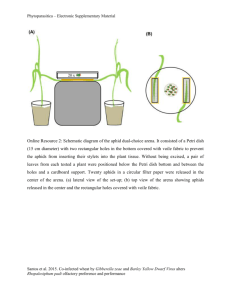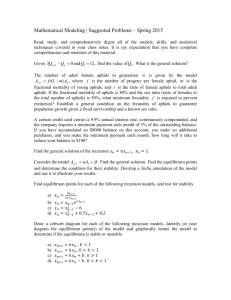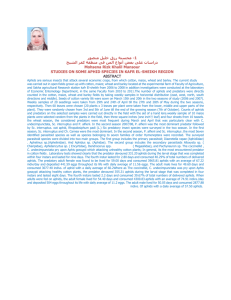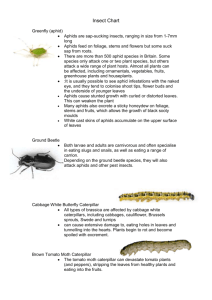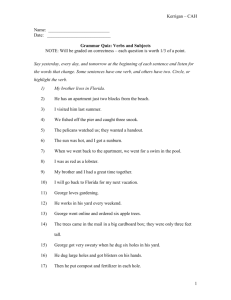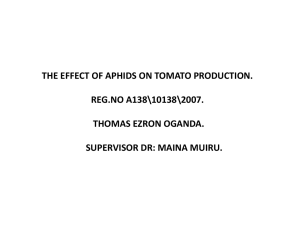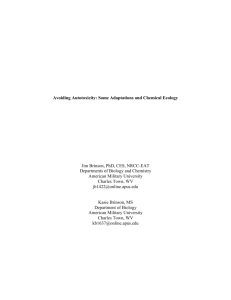Facultative bacterial symbionts in aphids confer resistance to parasitic wasps
advertisement
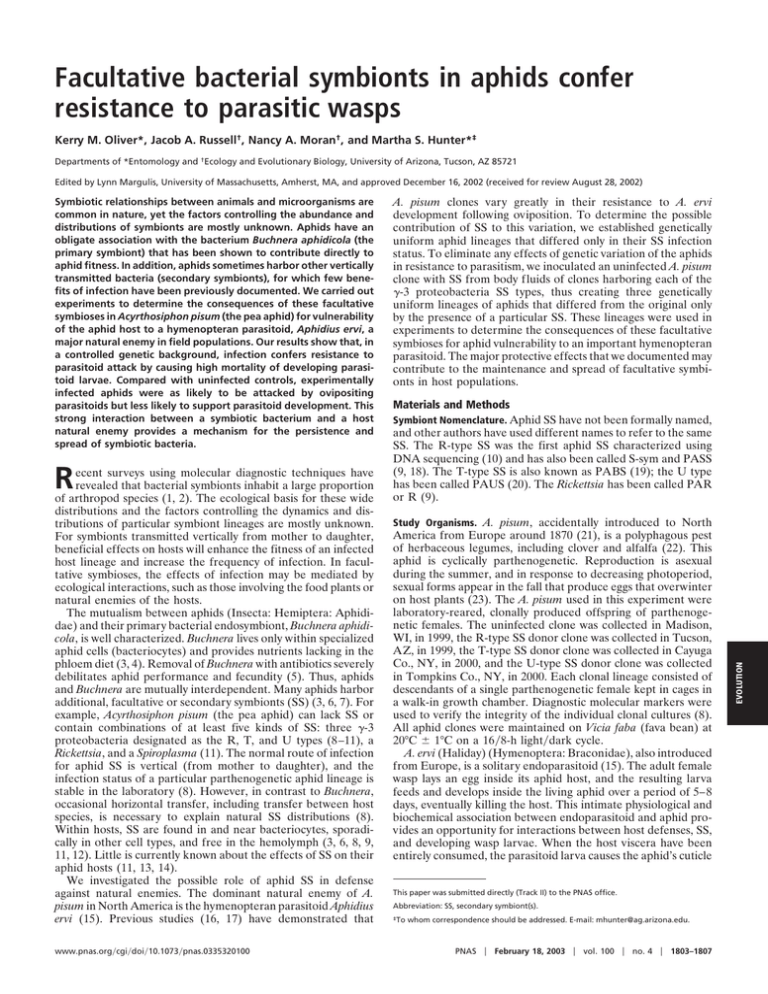
Facultative bacterial symbionts in aphids confer resistance to parasitic wasps Kerry M. Oliver*, Jacob A. Russell†, Nancy A. Moran†, and Martha S. Hunter*‡ Departments of *Entomology and †Ecology and Evolutionary Biology, University of Arizona, Tucson, AZ 85721 Edited by Lynn Margulis, University of Massachusetts, Amherst, MA, and approved December 16, 2002 (received for review August 28, 2002) R ecent surveys using molecular diagnostic techniques have revealed that bacterial symbionts inhabit a large proportion of arthropod species (1, 2). The ecological basis for these wide distributions and the factors controlling the dynamics and distributions of particular symbiont lineages are mostly unknown. For symbionts transmitted vertically from mother to daughter, beneficial effects on hosts will enhance the fitness of an infected host lineage and increase the frequency of infection. In facultative symbioses, the effects of infection may be mediated by ecological interactions, such as those involving the food plants or natural enemies of the hosts. The mutualism between aphids (Insecta: Hemiptera: Aphididae) and their primary bacterial endosymbiont, Buchnera aphidicola, is well characterized. Buchnera lives only within specialized aphid cells (bacteriocytes) and provides nutrients lacking in the phloem diet (3, 4). Removal of Buchnera with antibiotics severely debilitates aphid performance and fecundity (5). Thus, aphids and Buchnera are mutually interdependent. Many aphids harbor additional, facultative or secondary symbionts (SS) (3, 6, 7). For example, Acyrthosiphon pisum (the pea aphid) can lack SS or contain combinations of at least five kinds of SS: three ␥-3 proteobacteria designated as the R, T, and U types (8–11), a Rickettsia, and a Spiroplasma (11). The normal route of infection for aphid SS is vertical (from mother to daughter), and the infection status of a particular parthenogenetic aphid lineage is stable in the laboratory (8). However, in contrast to Buchnera, occasional horizontal transfer, including transfer between host species, is necessary to explain natural SS distributions (8). Within hosts, SS are found in and near bacteriocytes, sporadically in other cell types, and free in the hemolymph (3, 6, 8, 9, 11, 12). Little is currently known about the effects of SS on their aphid hosts (11, 13, 14). We investigated the possible role of aphid SS in defense against natural enemies. The dominant natural enemy of A. pisum in North America is the hymenopteran parasitoid Aphidius ervi (15). Previous studies (16, 17) have demonstrated that www.pnas.org兾cgi兾doi兾10.1073兾pnas.0335320100 A. pisum clones vary greatly in their resistance to A. ervi development following oviposition. To determine the possible contribution of SS to this variation, we established genetically uniform aphid lineages that differed only in their SS infection status. To eliminate any effects of genetic variation of the aphids in resistance to parasitism, we inoculated an uninfected A. pisum clone with SS from body fluids of clones harboring each of the ␥-3 proteobacteria SS types, thus creating three genetically uniform lineages of aphids that differed from the original only by the presence of a particular SS. These lineages were used in experiments to determine the consequences of these facultative symbioses for aphid vulnerability to an important hymenopteran parasitoid. The major protective effects that we documented may contribute to the maintenance and spread of facultative symbionts in host populations. Materials and Methods Symbiont Nomenclature. Aphid SS have not been formally named, and other authors have used different names to refer to the same SS. The R-type SS was the first aphid SS characterized using DNA sequencing (10) and has also been called S-sym and PASS (9, 18). The T-type SS is also known as PABS (19); the U type has been called PAUS (20). The Rickettsia has been called PAR or R (9). Study Organisms. A. pisum, accidentally introduced to North America from Europe around 1870 (21), is a polyphagous pest of herbaceous legumes, including clover and alfalfa (22). This aphid is cyclically parthenogenetic. Reproduction is asexual during the summer, and in response to decreasing photoperiod, sexual forms appear in the fall that produce eggs that overwinter on host plants (23). The A. pisum used in this experiment were laboratory-reared, clonally produced offspring of parthenogenetic females. The uninfected clone was collected in Madison, WI, in 1999, the R-type SS donor clone was collected in Tucson, AZ, in 1999, the T-type SS donor clone was collected in Cayuga Co., NY, in 2000, and the U-type SS donor clone was collected in Tompkins Co., NY, in 2000. Each clonal lineage consisted of descendants of a single parthenogenetic female kept in cages in a walk-in growth chamber. Diagnostic molecular markers were used to verify the integrity of the individual clonal cultures (8). All aphid clones were maintained on Vicia faba (fava bean) at 20°C ⫾ 1°C on a 16兾8-h light兾dark cycle. A. ervi (Haliday) (Hymenoptera: Braconidae), also introduced from Europe, is a solitary endoparasitoid (15). The adult female wasp lays an egg inside its aphid host, and the resulting larva feeds and develops inside the living aphid over a period of 5–8 days, eventually killing the host. This intimate physiological and biochemical association between endoparasitoid and aphid provides an opportunity for interactions between host defenses, SS, and developing wasp larvae. When the host viscera have been entirely consumed, the parasitoid larva causes the aphid’s cuticle This paper was submitted directly (Track II) to the PNAS office. Abbreviation: SS, secondary symbiont(s). ‡To whom correspondence should be addressed. E-mail: mhunter@ag.arizona.edu. PNAS 兩 February 18, 2003 兩 vol. 100 兩 no. 4 兩 1803–1807 EVOLUTION Symbiotic relationships between animals and microorganisms are common in nature, yet the factors controlling the abundance and distributions of symbionts are mostly unknown. Aphids have an obligate association with the bacterium Buchnera aphidicola (the primary symbiont) that has been shown to contribute directly to aphid fitness. In addition, aphids sometimes harbor other vertically transmitted bacteria (secondary symbionts), for which few benefits of infection have been previously documented. We carried out experiments to determine the consequences of these facultative symbioses in Acyrthosiphon pisum (the pea aphid) for vulnerability of the aphid host to a hymenopteran parasitoid, Aphidius ervi, a major natural enemy in field populations. Our results show that, in a controlled genetic background, infection confers resistance to parasitoid attack by causing high mortality of developing parasitoid larvae. Compared with uninfected controls, experimentally infected aphids were as likely to be attacked by ovipositing parasitoids but less likely to support parasitoid development. This strong interaction between a symbiotic bacterium and a host natural enemy provides a mechanism for the persistence and spread of symbiotic bacteria. to stretch, harden and dry, a process known as mummification. An adult A. ervi emerges from an aphid mummy and is freeliving. Approximately 100 A. ervi wasps were collected as mummies in Tompkins Co., NY, in 2000. The wasp culture was maintained in the laboratory on the uninfected aphid clone at 20°C ⫾ 1°C on a 16兾8-h light兾dark cycle. Honey and water were provided to adult wasps. Microinjection Procedure and Verification of SS Composition. We used a technique, pioneered by Chen and Purcell (18), to inoculate an uninfected aphid clone (i.e., containing no SS) with symbionts from infected clones, allowing us to study the effects of particular SS in a common genetic background. Curing SS with antibiotics has not been a viable option because of the concurrent harm to the primary symbiont, Buchnera, on which aphid survival and reproduction depends (9). We transferred body fluids from three donor aphid clones that were each singly infected with the R-, T-, or U-type SS into different individuals of the same uninfected aphid clone to create three genetically uniform lineages of aphids that differed from original (i.e., uninfected) only by the presence of a single particular SS. All three singly infected lineages and the uninfected lineage were descendants of a single isolated parthenogenetic female and were maintained as separate parthenogenetically reproducing cultures. Microinjections for each SS type were accomplished as follows. Aphids were immobilized on a pipette tip attached to a vacuum on a compound microscope stage. Body fluids were extracted from an apterous adult donor with a microinjection needle. Recipients were second to fourth instar aphids from a single uninfected clone. Body fluids from the donor were injected into the body cavities of the recipients, which were then placed individually on fava bean plants in a small cup cage. The cup cage was made from a modified inverted 473-ml transparent Solo cup (SOL no. 13) sealed to a planting pot (diameter ⫽ 9 cm) with parafilm and masking tape. The cup was modified by removing the bottom and replacing it with organdy fabric for ventilation. After 9 days, surviving injected aphids were transferred to new fava bean plants (one aphid per plant). Offspring were then screened for SS using diagnostic PCR primers as described in Sandström et al. (8). Diagnostic PCR was conducted at 10-l volumes using standard reaction mix (24) and a cycle of 94°C for 1 min, 58°C for 1 min, and 72°C for 2 min, repeated 35 times, and then 72°C for 6 min. In cultures (individual cup cages) that tested positive for SS, single surviving offspring were placed on V. faba and allowed to reproduce for several days. At this time, these adults were removed and tested again for SS. Cultures with adults testing negative were discarded, whereas those testing positive (one for each of the three SS types microinjected) were maintained as separate parthenogenetically reproducing cultures in the lab at 20°C and in an 18兾6-h light兾dark cycle. Maintenance of Aphid Lines. To allow SS densities to approach equilibrium within the aphid host, parasitism assays were conducted a minimum of 10 generations after the artificial inoculation procedure. Therefore, infections represent stable associations, and the artificially infected lines did not exhibit any obvious abnormalities of growth or morphology. The experimental lineages were maintained in a building in which no other aphid clones of the same SS infection status were present. However, to be certain that all of the experimental lineages were of the same nuclear genotype, we performed intersequence simple repeats, a diagnostic fingerprinting technique, to verify clone integrity (8, 25). To prevent contamination among experimental lineages (e.g., artificially infected T type entering artificially infected R-type cultures), we regularly screened aphids with diagnostic PCR to ensure lineage identity and the persistence of SS in their new hosts. 1804 兩 www.pnas.org兾cgi兾doi兾10.1073兾pnas.0335320100 Comparison of Artificially Inoculated Aphids with Naturally Symbiotic Aphids. We performed real-time quantitative PCR using a Light- cycler (Roche Molecular Biochemicals) to estimate and compare SS densities in naturally symbiotic and artificially inoculated aphids harboring R-type SS. Aphids were flash frozen in liquid nitrogen at age 8 h ⫾ 1 h and age 72 h ⫾ 1 h and stored at ⫺80°C until DNA extraction of single whole aphids (26). Primers were designed to amplify a 193-bp fragment of the recA gene from R-type SS (recArtype172F GGAAATCTGTGATGCTCTGAC and recArtype364R CATACGAATCTGGTTGATGAAG). Buchnera lacks recA, and aphids lacking SS give no PCR product with these primers. As a negative control, we performed quantitative PCR with the recA primers on an aphid with the T-type SS (lacking the R type) to ensure that these primers were R-type specific. The 20-l quantitative PCR reactions contained 0.5 M of each primer, 1⫻ SYBR Green MasterMix (Qiagen, Valencia, CA), and 10 pmol of template DNA. Reaction conditions were as follows: one cycle of 95°C for 15 min, followed by 35 cycles of 94°C for 5 s, 58°C for 20 s, and 72°C for 17 s. At the end of each run, a melting curve analysis was performed, which allowed us to confirm the identity and specificity of amplified products. A standard curve was generated using two independent serial dilutions of a TOPO TA plasmid vector (Invitrogen) containing a single fragment of the R-type SS recA gene, generated on a regular thermocycler using the above recA primers. Because recA is a single-copy chromosomal gene in almost all bacterial genomes, the estimated copy gives an approximation of SS numbers. We also calculated the relative DNA concentrations of each sample using aphid EF1-alpha primers (ApEF1alpha 107F CTGATTGTGCCGTGCTTATTG and ApEF1alpha 246R TATGGTGGTTCAGTAGAGTCC) in Lightcycler reactions by generating a standard curve using two independent serial dilutions of aphid DNA. We then calibrated our recA copy numbers accordingly. An ANOVA was performed to compare values obtained from artificially and naturally infected hosts. Light microscopy of hemolymph and single bacteriocytes extracted from aphids artificially inoculated with the R-type SS was conducted to verify that SS reside in locations similar to those reported for naturally symbiotic aphids (9, 12). Single bacteriocytes were extracted from aphids dissected in insect Ringer’s solution and put through a series of saline washes to eliminate possible contamination from SS in the hemolymph. Samples were then placed on a microscope slide, heat-fixed, and stained with Giménez stain (27). Primary and secondary symbionts are easily distinguished with this technique; SS are small and rod-shaped, whereas Buchnera are relatively large and round. Parasitism Assays. In three separate experiments, we compared the rates of successful parasitism of each of these artificially inoculated lineages of A. pisum against an uninfected control lineage of the same genotype. In each experiment, 30 second instar pea aphids were placed on a potted V. faba plant in a cup cage 20–24 h before wasp introduction. Aphid mummies were removed from the culture and enclosed in a separate holding container to ensure that experimental wasps were of similar age and had no prior oviposition experience. Upon emerging, wasps were provided with water and honey ad libitum. Wasps used in experiments were 3–5 days posteclosion and were assumed to be mated. Wasps were given oviposition experience by exposing them to five uninfected second instar aphids in a Petri dish (diameter ⫽ 5 cm) just before the experiment. Any wasp that did not oviposit in an aphid within 5 min of introduction in the Petri dish was excluded from the experiment. Females with oviposition experience were then individually assigned at random to either treatment (inoculated with SS) or control (uninfected) arenas. The wasps were removed from the arena after 6 h. Arenas, incubated at 20°C ⫾ 1°C in a 16兾8-h light兾dark cycle, Oliver et al. were examined after 10 days, and the numbers of mummies were counted to determine susceptibility to parasitism. Arenas that had suffered no parasitism or had more than six missing aphids were discarded from the analysis. Host Suitability Versus Host Acceptability. Observed differences in resistance to parasitism could reflect differences in the parasitoid’s acceptance of infected and uninfected aphids or differences in developmental success following parasitism. We distinguished between these possibilities in trials in which 30 second instar aphids were singly parasitized in a Petri dish (diameter ⫽ 3.5 cm) by a 3- to 5-day-old A. ervi. In each replicate, 15 of the 30 aphids were dissected in saline solution within 4 h of parasitism, and eggs were counted to determine if A. ervi had oviposited in the aphid host. The other 15 aphids were incubated on plants at 20°C ⫾ 1°C in a 16兾8-h light兾dark cycle for 10 days, at which time mummies were counted to determine susceptibility to parasitism. We compared numbers of eggs deposited and numbers of mummies formed among R-infected, T-infected, and uninfected (control) aphids. We conducted 12 replicates of the control and R-infected lineages and 10 replicates of the Tinfected lineage. Results Comparison of Artificially Inoculated Aphids with Naturally Symbiotic Aphids. Using real-time quantitative PCR, we found no differ- ence in SS densities between naturally symbiotic aphids and those artificially inoculated with the R-type SS in either 8-h-old aphids (ANOVA, F1,18 ⫽ 0.044, P value ⫽ 0.84, n ⫽ 10) or 72-h-old aphids (ANOVA, F1,18 ⫽ 0.012, P value ⫽ 0.91, n ⫽ 10). Furthermore, light microscopy indicates that R-type SS can be found in both the bacterioctyes and hemolymph of aphids artificially inoculated with the R-type SS, as has been described in naturally infected aphids (9, 12). These results suggest that SS behave in a similar manner in naturally symbiotic and artificially inoculated aphids, thereby validating the microinjection procedure as a useful tool to experimentally manipulate host symbiont compositions. Do A. pisum SS Confer Resistance to the Parasitoid A. ervi ? A. pisum inoculated with the R-type SS showed a 22.5% reduction in mummy formation compared with uninfected controls (ANOVA, F1,38 ⫽ 6.9, P value ⫽ 0.013). In 20 replicates, each with 30 aphids exposed, parasitoids produced a mean of 17.1 mummies (95% CI ⫽ 14.8–19.3) on the R-infected aphids compared with 22.0 mummies in uninfected aphids (95% CI ⫽ 20.3–24.9) (Fig. 1). Pea aphids inoculated with the T-type SS conferred an even greater reduction (41.5%) in mummy formation compared with uninfected controls (ANOVA, F1,28 ⫽ 20.0, P value ⫽ 0.0001). In this case, a mean of only 12.1 T-infected aphids was successfully parasitized (95% CI ⫽ 9.4–14.9, n ⫽ 15) (Fig. 1) compared with a mean of 20.6 mummies in uninfected Oliver et al. Fig. 1. Effect of SS infection on susceptibility of A. pisum to parasitism by A. ervi. Each value is the mean number of mummies (⫽ successful parasitism) out of a possible 30, ⫾ SE. In all experiments, the same aphid clonal lineage served as a source of uninfected aphids and as a recipient for artificial infection with the U-, R-, or T-type SS. Aphids infected with either the R- or the T- type SS were significantly less likely to succumb to parasitism. Numbers above columns are replicates (N). *, P ⬍ 0.05; ***, P ⬍ 0.001. aphids of this clone (95% CI ⫽ 17.9–23.3). In contrast, the U-type SS did not seem to confer resistance; infected and uninfected aphids were similarly susceptible to parasitism (ANOVA, F1,22 ⫽ 0.2, P value ⫽ 0.66, n ⫽ 12) (Fig. 1). Host Suitability Versus Host Acceptability. We found no difference in the number of eggs laid in uninfected, R-infected, or Tinfected aphids (ANOVA, F2,31 ⫽ 0.02, P value ⫽ 0.98) (Fig. 2), indicating that A. ervi does not avoid ovipositing in hosts infected with SS. However, despite receiving similar numbers of parasitoid eggs, pea aphids harboring the R- and T-type SS were less susceptible to successful parasitism than uninfected aphids (ANOVA, F2,31 ⫽ 13.38, P value ⬍ 0.0001) (Fig. 2). Thus, eggs were laid in equal numbers in uninfected hosts and hosts with the R- and T-type SS, but fewer of those individuals survived to pupate in R- and T-type aphids. As in the previous experiment, R- and T-infected aphids showed approximately a 20% and 40% reduction in mummy formation, respectively, compared with uninfected controls. Timing of Resistance in R-Infected Aphids. Uninfected and R- infected aphids did not differ significantly in the number of parasitoid eggs laid nor in the initiation of embryogenesis in eggs in the period between 0 and 24 h postoviposition (data not shown). We also found no effect of infection on the number or condition of larvae that were between 3 and 4 days postoviposition (Fig. 3). From 4 to 5 days after oviposition, we found similar numbers of larvae in both treatments, but the aphids inoculated with the R-type SS had significantly more moribund and dead larvae than their uninfected counterparts (Fig. 3, ANOVA, F1,351 ⫽ 18.2, P value ⬍ 0.0001). This mechanism of resistance is different from that described by previous studies PNAS 兩 February 18, 2003 兩 vol. 100 兩 no. 4 兩 1805 EVOLUTION Timing of Resistance in R-Infected A. pisum. We performed serial dissections to follow the course of developing A. ervi individuals within the R-infected and uninfected aphid hosts. Aphids were dissected in the following time intervals: 0–24 h, 3–4 days, and 4–5 days. A. ervi eggs are found between 0 and 24 h and larvae are found after 3 days. Dissected A. ervi eggs were fixed in a chloroform, ethanol, and glacial acetic acid mix (4:3:1, by volume) for 2–5 min. Fixed eggs were then stained with a drop of 2% lacto-aceto-orcein for ⬇10 min to assess embryonic development. In dissected aphids containing A. ervi larvae (post 72 h), we noted the presence and condition of larvae. Larvae were scored as healthy or as moribund or dead. Aphids were not examined between 24 and 72 h because A. ervi embryos could not reliably be found during this developmental period of major morphological changes (28). Fig. 2. Comparison of the mean number of A. ervi eggs found (within 4 h of oviposition) and the mean number of mummies formed (10 days postoviposition) in singly parasitized R- and T-infected A. pisum vs. uninfected controls. A. ervi were as likely to oviposit in aphids infected with the R- and T-type SS as in uninfected controls (CON), but significantly fewer progeny developed to pupation (P value ⬍ 0.0001). Numbers above columns are replicates (N). (16, 17), in which A. ervi eggs remained visible but did not seem to initiate embryogenesis in resistant A. pisum clones. Discussion In A. pisum artificially inoculated with the R- and T-type SS, successful parasitism was reduced by 22.5% and 41.5%, respectively, compared with parasitism rates in uninfected controls (Fig. 1). That two of the three SS strains we examined conferred resistance to parasitism by A. ervi indicates that bacterial symbionts may play an important role in mediating interactions between A. pisum and their natural enemies. A strong interaction between a symbiotic bacterium and a host natural enemy provides a mechanism for the persistence and spread of symbiotic bacteria and indicates that symbiont dynamics must be evaluated in the context of the ecological conditions of particular populations. In particular, we predict higher frequencies of Rand T-type SS in populations of A. pisum in which A. ervi is prevalent. Why have lineages infected with SS not spread to fixation in A. pisum populations? Another study (13), which also used artificially inoculated pea aphids, revealed that those with the R-type SS (called ‘‘PASS’’ in that study) suffered reduced longevity and fecundity at 20°C compared with uninfected counterparts. This suggests that a tradeoff may exist between resistance to parasitism and fecundity and longevity at temperatures commonly found in aphid habitats. Balancing selection might then maintain the variety of SS compositions found among aphid clones, with the infection frequencies dependent on temperature and the prevalence of parasitoids within particular populations. It is important to note, however, that our study only considered the effects of single isolates of particular SS types (e.g., U type). A symbiont type is designated based on 16S rDNA molecular phylogenetic analysis (8), and it is possible that different isolates of a particular symbiont type exhibit different phenotypes. For example, other isolates of the U-type SS may confer resistance to parasitism. 1806 兩 www.pnas.org兾cgi兾doi兾10.1073兾pnas.0335320100 Fig. 3. Percent of A. ervi larvae found in singly parasitized hosts and the percent of found larvae that were healthy in R-infected A. pisum vs. uninfected controls. Dissections were performed during the interval between 3 and 4 days and between 4 and 5 days. Significantly fewer larvae in R-infected aphids were healthy at 4 –5 days; the remainder were dead or moribund. For R-infected aphids, n ⫽ 177 for 3– 4 days and 223 for 4 –5 days, whereas for uninfected aphids, n ⫽ 180 for 3– 4 days and 215 for 4 –5 days. ***, P ⬍ 0.001. We found that observed differences in resistance reflect differences in developmental success of A. ervi following parasitism rather than differences in acceptance of infected or uninfected hosts (Fig. 2). Infection confers resistance to parasitoid attack by causing high mortality in developing parasitoid larvae in R-infected aphids 4–5 days after oviposition (Fig. 3). Further work is needed to determine the specific mechanism of resistance in SS-infected aphids. The mechanism of resistance may simply reflect a heightened generalized immune response to invaders following a recent association with SS. If this is the case, then this heightened immune response varies with the particular SS association (e.g., U-type SS do not confer resistance), and the immune effect persists for many generations after inoculation. For example, R-infected aphids assayed for resistance ⬇60 generations postinoculation showed the same pattern of resistance as those assayed 10 generations postinoculation (K.M.O., unpublished data). Alternatively, SS may harm or kill the developing wasp larva directly via toxic secretions or indirectly by altering the host metabolism balance. Others researchers have proposed a physiological model of host regulation in this system, in which wasp venom and teratocytes (large cells derived from the extraembryonic membrane of the wasp larva) function in tandem to redirect nutritional resources from aphid embryos to the developing parasitoid larva (29). One intriguing possibility is that A. pisum SS function to interrupt this process, possibly by suppressing the development of teratocytes such that developing wasp larvae cannot meet their nutritional needs. In support of this hypothesis, a recent study indicates that the absence of functional teratocytes in a resistant A. pisum clone accounts for the reduction of successful A. ervi larval development (30). In any case, it is apparent that the response is graded; not all parasitoids succumb to SS-mediated defense, and levels of resistance are different for all three SS. A. ervi individuals show Oliver et al. genetic variation in virulence (31) when attacking pea aphids, which may explain why some parasitoids are able to overcome SS-mediated defenses. Our wasp culture was initiated from ⬇100 aphid mummies, and ⬇100 wasps are allowed to reproduce each generation; this is likely a large enough population size to expect variation in virulence. To invade a host population, vertically transmitted endosymbionts must increase host fitness or manipulate host reproduction in ways that increase their own transmission (32). Parasitized aphids infected with SS will benefit directly if they produce more offspring on average than parasitized aphids that are not infected. Preliminary evidence indicates that parasitized R- and T-infected A. pisum are more fecund than parasitized uninfected controls (K.M.O., unpublished data). Further, resistance may confer indirect benefits; fewer parasitoids emerging reduces the risk of parasitism for nearby clone mates. Kin selection has been well documented in other aphids with high genetic relatedness within colonies (33). Mutualisms in which one partner species provides shelter or nutrition while the other provides defense against natural ene- We thank Kim Hammond, Gordon Plague, Helen Dunbar, and Joshua White for technical assistance and consultations, and B. Tabashnik, J. Harvey, C. Gibson, D. Donnell, K. Hammond, and S. Kelly for comments on the manuscript. Funding was provided by National Science Foundation Biocomplexity Phase I Grant DEB-9978518 (to N.A.M.). J.A.R. was supported by a National Science Foundation兾U.S. Department of Agriculture training grant on plant–insect interactions. 1. Jeyaprakash, A. & Hoy, M. A. (2000) Insect Mol. Biol. 9, 393–405. 2. Werren, J. H. & Windsor, D. M. (2000) Proc. R. Soc. London Ser. B 267, 1277–1285. 3. Buchner, P. (1965) Endosymbiosis of Animals with Plant Microorganisms (Interscience, New York). 4. Douglas, A. E. (1998) Annu. Rev. Entomol. 43, 17–37. 5. Prosser, W. A. &, Douglas, A. E. (1991) J. Insect Physiol. 37, 713–719. 6. Fukatsu, T. & Ishikawa, H. (1993) J. Mol. Evol. 36, 568–577. 7. Fukatsu, T., Watanabe, K. & Sekiguchi, Y. (1998) Appl. Entomol. Zool. 33, 461–472. 8. Sandström, J. P., Russell, J. A., White, J. P. & Moran, N. A. (2001) Mol. Ecol. 10, 217–228. 9. Chen, D. Q., Campbell, B. C. & Purcell, A. H. (1996) Curr. Microbiol. 33, 123–128. 10. Unterman, B. M., Baumann, P. & McLean, D. L. (1989) J. Bacteriol. 171, 2970–2974. 11. Fukatsu, T., Tsuchida, T., Nikoh, N. & Koga, R. (2001) Appl. Environ. Microbiol. 67, 1284–1291. 12. Fukatsu, T., Nikoh, N., Kawai, R. & Koga, R. (2000) Appl. Environ. Microbiol. 66, 2748–2758. 13. Chen, D. Q., Montllor, C. B. & Purcell, A. H. (2000) Entomol. Exp. Appl. 95, 315–323. 14. Montllor, C. B., Maxmen, A. & Purcell, A. H. (2002) Ecol. Entomol. 27, 189–195. 15. Angalet, G. W. & Fuester, R. (1977) Ann. Entomol. Soc. Am. 70, 87–96. 16. Henter, H. J. & Via, S. (1995) Evolution (Lawrence, Kans.) 49, 427–438. 17. Ferrari, J., Müller, C. B., Kraaijeveld, A. R. & Godfray, H. C. J. (2001) Evolution (Lawrence, Kans.) 55, 1805–1814. 18. Chen, D. Q. & Purcell, A. H. (1997) Curr. Microbiol. 34, 220–225. 19. Darby, A. C., Birkle, L. M., Turner, S. L. & Douglas, A. E. (2001) FEMS Microbiol. Ecol. 36, 43–50. 20. Tsuchida, T., Koga, R., Shibao, H., Matsumoto, T. & Fukatsu, T. (2002) Mol. Ecol. 11, 2123–2135. 21. Mackauer, M. (1968) in Biological Control Programmes Against Insects and Weeds in Canada 1959–1968 (Tech. Comm. No. 4, Commonwealth Institute of Biological Control, Trinidad), pp. 3–11. 22. Eastop, V. F. (1966) Aust. J. Zool. 14, 399–592. 23. Lamb, R. J. & Pointing, P. J. (1972) J. Insect Physiol. 18, 2029–2042. 24. Moran, N. A., Kaplan, M. E., Gelsey, M. J., Murphy, T. G. & Scholes, E. A. (1999) Syst. Entomol. 24, 85–93. 25. Abbot, P. (2001) J. Insect Sci., http:兾兾insectscience.org兾, 1:8. 26. Engels, W. R., Johnsonschlitz, D. M., Eggleston, W. B. & Sved, J. (1990) Cell 62, 515–525. 27. Giménez, D. F. (1964) Stain Technol. 39, 135–140. 28. Grbic, M. & Strand, M. R. (1998) Proc. Natl. Acad. Sci. USA 95, 1097–1101. 29. Falabella, P., Tremblay, E. & Pennacchio, F. (2000) Entomol. Exp. Appl. 97, 1–9. 30. Li, S., Falabella, P., Giannantonio, S., Fanti, P., Battaglia, D., Digilio, M. C., Völkl, W., Sloggett, J. J., Weisser, W. & Pennacchio, F. (2002) J. Insect Physiol. 48, 971–980. 31. Henter, H. J. (1995) Evolution (Lawrence, Kans.) 49, 439–445. 32. Werren, J. H. & O’Neill, S. L. (1997) in Influential Passengers, eds. O’Neill, S. A., Hoffman, A. A. & Werren, J. H. (Oxford Univ. Press, Oxford), pp. 2–10. 33. Stern, D. L. & Foster, W. A. (1996) Biol. Rev. Cambridge Philos. Soc. 71, 27–79. 34. Janzen, D. H. (1966) Evolution (Lawrence, Kans.) 20, 249–275. 35. Hsiao, T. H. (1996) in Ecology of Agricultural Pests, eds. Symondson, W. O. C. & Lidell, J. E. (Chapman & Hall, London), pp. 51–71. 36. Kellner, R. L. L. (1999) Entomol. Exp. Appl. 93, 41–49. 37. Clay, K. (1990) Annu. Rev. Ecol. Syst. 21, 275–297. 38. Bernays, E. A. (1989) Evol. Ecol. 3, 299–311. Oliver et al. PNAS 兩 February 18, 2003 兩 vol. 100 兩 no. 4 兩 1807 EVOLUTION mies include such well known examples as ants and acacias (34), yet a defensive role of microbial endosymbionts in insects has rarely been considered (but see refs. 35 and 36). This discovery of an insect herbivore harboring bacterial symbionts that provide defense against parasitoids nicely parallels the finding that many grasses are chemically protected from herbivores by fungal endophytes (37). Given that endosymbionts, including facultative SS, are widespread in insects and that specific natural enemies are important selective forces in shaping the life history of many insects (38), the role of endosymbionts in the defense of herbivorous insects should be more generally explored.

